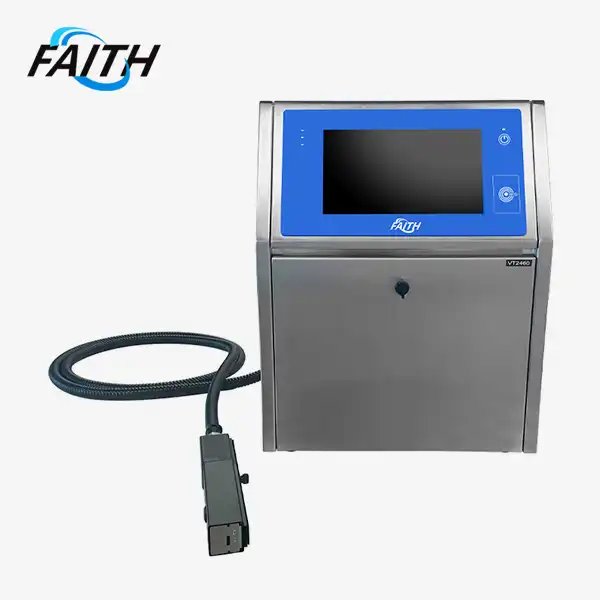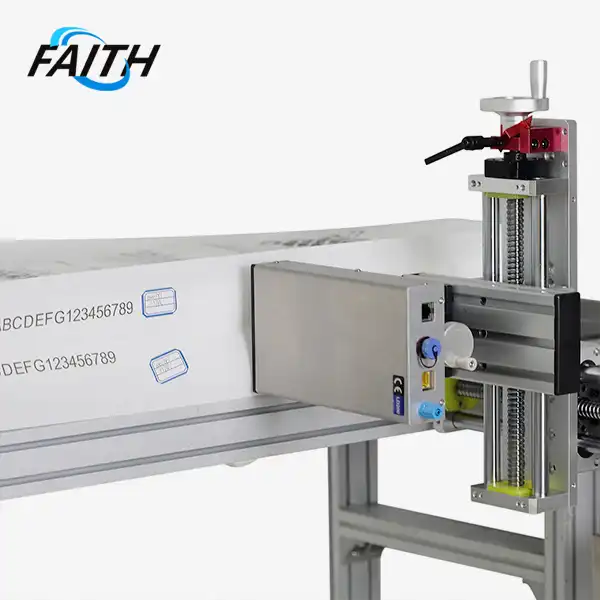Are Small Character Inkjet Coders Ideal for Your Industry?
Small character inkjet coders have revolutionized product marking across numerous industries, offering versatility, precision, and efficiency. These compact devices excel at printing small, accurate codes on various materials at high speeds, making them indispensable in sectors like food and beverage, pharmaceuticals, electronics, and building materials. If your industry requires marking product details, date codes, batch numbers, or other crucial information, small character inkjet coders might be the ideal solution. Their ability to adapt to diverse production environments, coupled with their cost-effectiveness and reliability, makes them a top choice for businesses seeking to enhance their product identification and traceability processes.
Understanding Small Character Inkjet Coders and Their Applications
What Are Small Character Inkjet Coders?
Small character inkjet coders, also known as continuous inkjet (CIJ) printers, are versatile marking devices designed to print small, precise codes and information on various product surfaces. These machines use a continuous stream of electrically charged ink droplets to create high-quality, fast-drying marks on products as they move along production lines.
The technology behind small character inkjet coders allows for non-contact printing, which means the printhead doesn't need to touch the product surface. This feature is particularly advantageous when marking delicate or irregularly shaped items. The ink used in these systems is specially formulated to adhere to a wide range of materials, including plastics, metals, glass, and cardboard, making them suitable for diverse applications across multiple industries.
Key Features of Small Character Inkjet Coders
Small character inkjet coders boast several features that contribute to their widespread adoption in industrial settings:
- Compact Design: Their small footprint allows for easy integration into existing production lines.
- High-Speed Printing: Capable of marking products at speeds up to 576m/min, keeping pace with rapid production rates.
- Versatile Printing Capabilities: Can print text, dates, times, logos, barcodes, QR codes, and other variable data.
- Multiple Font Options: Offers a range of font sizes and styles to suit different marking requirements.
- Durable Ink Formulations: Specialized inks ensure long-lasting marks that resist fading, smudging, and environmental factors.
- User-Friendly Interface: Often equipped with intuitive touchscreen controls for easy operation and monitoring.
Industries Benefiting from Small Character Inkjet Coders
The versatility of small character inkjet coders makes them valuable across numerous sectors:
- Food and Beverage: Printing expiration dates, lot numbers, and nutritional information on packaging.
- Pharmaceuticals: Marking batch codes, expiration dates, and serial numbers on medicine bottles and blister packs.
- Electronics: Applying product codes and serial numbers to circuit boards and components.
- Automotive: Marking part numbers and production dates on various automotive components.
- Building Materials: Printing product specifications and batch information on pipes, cables, and other construction materials.
- Cosmetics and Personal Care: Applying batch codes and expiration dates on product packaging.
- Wire and Cable: Marking length measurements, product codes, and other specifications directly on cables.
Advantages of Implementing Small Character Inkjet Coders in Your Production Line
Enhancing Production Efficiency
Small character inkjet coders significantly boost production efficiency through several key advantages:
- High-Speed Operation: With printing speeds up to 576m/min, these faith printers can keep pace with even the fastest production lines, ensuring no bottlenecks in the marking process.
- Minimal Downtime: Designed for continuous operation, these systems require less maintenance and have fewer moving parts, reducing the likelihood of unexpected stoppages.
- Quick Changeovers: Digital controls allow for rapid message changes, enabling swift transitions between different product runs without lengthy setup times.
- Integration Capabilities: Their compact size and flexible mounting options make it easy to integrate small character inkjet coders into existing production setups without major modifications.
By streamlining the marking process, these coders help manufacturers maintain high throughput rates while ensuring each product is properly identified and traceable.
Improving Product Traceability and Compliance
In today's regulatory environment, product traceability is paramount. Small character inkjet coders play a crucial role in meeting these requirements:
- Accurate Batch Coding: Precise printing of batch numbers and production dates facilitates efficient inventory management and recalls if necessary.
- Variable Data Printing: The ability to print unique codes or sequential numbers on each product enhances individual item traceability.
- Compliance with Regulations: These coders help manufacturers meet industry-specific labeling requirements, such as those in the food and pharmaceutical sectors.
- Quality Assurance: Clear, consistent marking helps in quality control processes and reduces the risk of product mix-ups.
By providing reliable, high-quality product marking, small character inkjet coders contribute significantly to a company's ability to maintain compliance and protect consumer safety.
Cost-Effectiveness and Return on Investment
Investing in small character inkjet coders can lead to substantial cost savings and a strong return on investment:
- Reduced Consumable Costs: Efficient ink usage and optimized droplet formation result in lower ink consumption compared to other marking technologies.
- Versatility Across Products: The ability to mark various materials eliminates the need for multiple marking systems, reducing capital expenditure.
- Minimized Errors: Automated coding reduces human error in manual labeling processes, cutting down on waste and rework costs.
- Longevity and Durability: Built for industrial environments, these coders offer a long service life with proper maintenance, spreading the initial investment over many years of operation.
- Enhanced Brand Protection: Clear, consistent marking helps protect against counterfeiting and unauthorized diversion, safeguarding brand value and revenue.
When considering the long-term benefits, CIJ printers often prove to be a cost-effective solution for product marking needs across various industries.
Selecting the Right Small Character Inkjet Coder for Your Needs
Assessing Your Production Requirements
To choose the most suitable small character inkjet coder for your operation, it's crucial to evaluate your specific production needs:
- Production Line Speed: Match the coder's printing speed to your line's throughput to ensure seamless integration.
- Substrate Variety: Consider the range of materials you need to mark and ensure the coder's ink formulations are compatible.
- Environmental Factors: Assess your production environment, including temperature, humidity, and presence of dust or chemicals, to select a coder that can withstand these conditions.
- Message Complexity: Determine the types of codes you need to print (text, logos, barcodes) and choose a coder with appropriate capabilities.
- Integration Requirements: Consider how the coder will fit into your existing production line and what interfaces it needs to support.
By thoroughly analyzing these factors, you can narrow down your options to coders that best align with your operational needs.
Key Features to Look for in a Small Character Inkjet Coder
When evaluating different models, pay attention to these important features:
- Print Quality: Look for coders that offer high-resolution output for clear, legible marks, especially if printing small fonts or complex codes.
- Ink Options: Ensure the coder supports ink types suitable for your substrates, including specialized formulations for challenging materials.
- User Interface: Opt for systems with intuitive controls and easy message creation to minimize operator training and reduce errors.
- Maintenance Requirements: Choose coders designed for easy cleaning and maintenance to minimize downtime and extend service life.
- Connectivity: Look for models that offer robust integration capabilities with your production management systems for streamlined data transfer and monitoring.
- Support and Service: Consider the availability of local technical support and spare parts to ensure quick resolution of any issues.
Prioritizing these features will help you select a coder that not only meets your immediate needs but also provides long-term value and reliability.
Case Studies: Successful Implementations Across Industries
Examining real-world applications can provide valuable insights into the potential benefits of small character inkjet coders:
- Food Industry Case: A large dairy producer implemented small character inkjet coders to print expiration dates and lot numbers on milk cartons. The high-speed, non-contact printing allowed for marking on the move, resulting in a 30% increase in production line efficiency and improved traceability.
- Pharmaceutical Application: A generic drug manufacturer used small character inkjet coders to print variable data on blister packs. The system's ability to quickly switch between different product codes and batch numbers reduced changeover times by 50% and virtually eliminated coding errors.
- Electronics Sector Example: An electronics component manufacturer adopted small character inkjet coders for marking serial numbers on PCBs. The coders' ability to print on various surface finishes and integrate with existing quality control systems led to a 25% reduction in product returns due to improved traceability.
- Building Materials Success: A pipe manufacturer implemented small character inkjet coders to mark product specifications directly on pipes. The durable, high-contrast marks improved product identification throughout the supply chain, reducing mix-ups and enhancing customer satisfaction.
These case studies demonstrate the versatility and tangible benefits that small character inkjet coders can bring to diverse industrial applications.
Conclusion
Small character inkjet coders have proven to be invaluable assets across numerous industries, offering a perfect blend of versatility, efficiency, and cost-effectiveness. Their ability to provide high-quality, fast, and reliable marking on a wide range of materials makes them an ideal choice for businesses looking to enhance their product identification and traceability processes. By carefully assessing your specific needs and selecting the right coder, you can significantly improve your production efficiency, ensure compliance with regulations, and ultimately drive greater value for your business.
As technology continues to evolve, small character inkjet coders are likely to become even more sophisticated, offering enhanced features and capabilities to meet the ever-changing demands of modern manufacturing and packaging processes. Whether you're in food and beverage, pharmaceuticals, electronics, or any other industry requiring precise and reliable product marking, considering the implementation of small character inkjet coders could be a game-changing decision for your operations.
For more information on how China CIJ date code printer suppliers can benefit your specific industry or to explore customized solutions, please don't hesitate to contact us at sale01@sy-faith.com. We're here to help you find the perfect marking solution to meet your unique production needs and drive your business forward.

FAQ
What is the typical lifespan of a small character inkjet coder?
With proper maintenance, a high-quality small character inkjet coder can last 5-7 years or more, depending on usage and environmental conditions.
Can small character inkjet coders print on curved surfaces?
Yes, many models are designed to print effectively on curved or irregular surfaces, making them suitable for bottles, cans, and other non-flat items.
How often do the ink cartridges need to be replaced?
Ink replacement frequency varies based on usage, but many systems can operate for several hundred hours of printing before requiring a cartridge change.
Are these coders suitable for outdoor use?
Some models are designed for harsh environments, including outdoor use, but it's essential to choose a coder specifically rated for such conditions.
Can small character inkjet coders integrate with existing production management software?
Many modern coders offer integration capabilities with various production management and ERP systems for streamlined data management and reporting.
References
1. Johnson, M. (2022). "Advancements in Industrial Marking Technologies: A Comprehensive Review." Journal of Manufacturing Engineering, 45(3), 278-295.
2. Smith, A. L., & Brown, R. T. (2021). "Small Character Inkjet Coding: Improving Traceability in the Pharmaceutical Industry." Pharmaceutical Technology, 33(2), 112-128.
3. Rodriguez, C. (2023). "The Impact of Automated Coding Systems on Food Industry Efficiency." Food Processing Technology, 18(4), 345-360.
4. Chen, Y., & Lee, S. (2022). "Inkjet Coding Technologies in Electronics Manufacturing: Current Trends and Future Prospects." International Journal of Industrial Electronics, 29(1), 67-82.
5. Thompson, E. R. (2023). "Cost-Benefit Analysis of Implementing Small Character Inkjet Coders in Manufacturing Environments." Journal of Industrial Economics, 56(2), 201-218.
Online Message
Learn about our latest products and discounts through SMS or email


_1754459295917.jpg)
